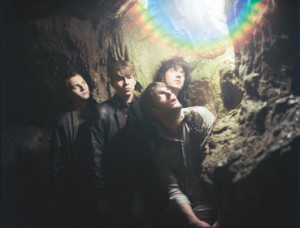Klaxons’ newest album strays from usual sound
When British four-piece band Klaxons played its first U.S. show at the week-old Echoplex in April of 2007, the audience in the packed venue couldn’t stop dancing. Caustic guitars, frantic bass lines and falsetto choruses disguised catchy keyboard riffs that got feet moving to the band’s self-invented genre of nu-rave, even if no one really understood what it meant.

Saying goodbye · The newest album’s tracks show obvious influence from a new producer and do not match the characteristic Klaxon sound. - Photo courtesy of Press Here Publicity
Band members’ affinities for brightly colored clothing aside, the music evoked more Arctic Monkeys or At The Drive In than traditional rave music.
Lyrical references to Thomas Pynchon, J.G. Ballard and other far-out authors further distanced them from any outfits that could be considered contemporaries.
Klaxons’ debut album Myths of the Near Future further alienated the band from definition.
Produced by Simian Mobile Disco’s James Ford, its theatrical songwriting made it one of those British exports that was overhyped yet simultaneously underrated.
The band members’ high-energy live shows and intensity helped them beat out Amy Winehouse for the 2007’s Best New Artist Mercury award, making them instant media darlings.
But after their successful win, the band evaded the spotlight, opting for time in Peru with the psychedelic drug ayahuasca instead.
When members finally re-emerged for interviews, Klaxons were in the process of recording their follow-up album with Ford, which they described to one journalist at the time as “noisy weirded-out prog.”
A year and a half later, after well-publicized rumors of the record label rejecting most of the finished songs and deeming them too experimental, Klaxons hit the studio with producer Ross Robinson and re-invented themselves with Surfing the Void, the band’s long-awaited sophomore album.
Released in the U.K. last August, Klaxons’ latest album was released last week in the United States as a deluxe edition with four extra songs, and beats out Best Coast for the funniest LOLcat album cover of the year. It’s a disappointing departure, though, from the raw energy and cluttered musicianship that made Myths so unique.
Robinson, of Korn, Slipknot and Blood Brothers, fame brought his nu-metal experience to the band, whittling down the psychedelic songs it had written and transforming the once indescribable band into a polished pop rock four-piece.
After the band had indulged in crazy time signatures and free-form association for the album-that-never-was, Robinson tried to shape the guys into a studio-worthy act for Void and the result is ten tracks of cleaned-up songs played by newly cleaned-up musicians.
The problem, however, is that Klaxons aren’t supposed to sound clean.
For all of Robinsons’ good intentions and professional recording techniques, the album falls short of its true potential.
In addition to lackluster songwriting on many of the tracks, the album suffers from production meant for a heavier, more Robinson-esque band.
Even on the songs where all of the elements are there, the perfectionist recording creates dissonance in the ears of those yearning for older, more blown-out anthems such as “Golden Skans” and “Atlantis to Interzone.”
The problem isn’t so much the musical direction that Klaxons have taken on Void, but the compressed pop sounds of Robinson’s production that are unbecoming for a band that once embraced gritty highs and lows.
Void’s opener “Echoes” and the first single “Flashover” sound most like what older fans would recognize as a Klaxons song, but something is missing in both. The drums are muted, the bass line isn’t dancing circles around the vocals and the space-age sounds are more strategically placed than atmospheric add-ins.
The second song on the album, “The Same Space,” is a catchy four-fourths song whose soaring vocals and thundering drums unfortunately belong more on My Chemical Romance’s The Black Parade than a Klaxons follow-up.
The same could be said for other tracks on the album such as “Venusia,” “Valley of Calm Trees” and “Future Memories,” whose slow tempos and mediocre vocal layering epitomizes the symptoms that arise when each instrument is recorded separately and mixed together later in Pro Tools.
If Klaxons hoped for American redemption with the “deluxe” portion of the album, this also missed the mark.
Instead of using the extra space as a way to share some experimental songs that didn’t make it onto the original album, it is instead an acoustic version of “Echoes” followed by a three-song digression into more blown-out pop songs.
The only redemption that may be possible for Void lies in Klaxons’ concerts. YouTube videos show much more unrefined live renditions of the album’s salvageable tunes, indicating that without Robinson’s influence, the band still possesses the power and talent to move feet on both sides of the pond.
